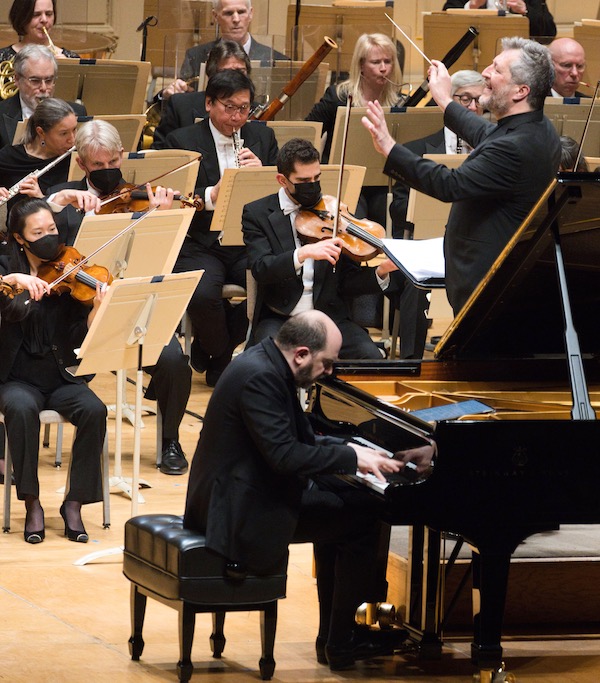Adès’ Piano Concerto even better the second time around with composer, Gerstein, BSO

Kirill Gerstein performed Thomas Adès’ Piano Concerto with the composer conducting the Boston Symphony Orchestra Thursday night at Symphony Hall. Photo: Hilary Scott
Prior to Thursday night, it had been nearly three years since Boston Symphony Orchestra artistic partner Thomas Adès had last appeared at Symphony Hall.
It was good to have him back. One of the best appointments of the Andris Nelsons era, Adès’ programs are always stimulating. They usually include his own music and the BSO typically responds to his conducting with immediacy. The composer’s herky-jerky podium style consistently inspires some of the BSO’s best playing each season.
Such was the case again on Thursday in a concert that paired Adès own Concerto for Piano and Orchestra with pieces by Alban Berg and Maurice Ravel.
Premiered during Adès’ last residency in Boston in 2019, the concerto impressed on that occasion with its gleeful wit and sheer sense of play—not to mention its immense technical demands. The score came across as both a knowing send-up of the grand, 19th-century concerto tradition and a serious, 21st-century continuation of that form.
On Thursday, with its dedicatee, Kirill Gerstein, again at the keyboard, the music’s impish playfulness was on full display, especially during its rambunctious first movement. Yet even more notable this week were the deep reservoirs of pathos and introspection Gerstein and friends mined from its pages. The concerto now sounds darker, tighter, more lyrical, and less nervous than before.
Those qualities are most evident in the sober central Andante gravemente, with its implacable descending melodic lines and resonant textures. But they also emerge potently in the outer movements.
On Thursday, the opening Allegramente’s moments of repose glowed. Meanwhile, the concluding half of the finale was starkly shaded by echoes of the second movement around its midpoint.
Throughout, there was a bracing frisson on display between pianist, orchestra, and composer/conductor.
For color and flexibility of phrasing, Thursday’s account was a revelation. Adès’ complex metrical schemes unfolded with enchanting naturalness. The score’s busy textures, like the first movement’s subtly heaving accompaniments with muted brasses, were faultlessly blended. And the music’s exposed moments—especially those in the second and third movements—were played with rapt intensity.
At the center of it all was Gerstein, whose command of Adès’ style and language is total. His handling of the solo part wanted for nothing: even more than the first time, it overflowed with Adès-ian spirit, sonority, and style.
Much the same can also be said for his account of Maurice Ravel’s 1932 Concerto for the Left Hand.
Everything about Gerstein’s rendering of this piece on Thursday was captivating, from the smartly shaped, cleanly voiced reading of the opening cadenza to his beautifully flowing, luminous take on its concluding solo. In between came snapping, characterful exchanges with the orchestra in the work’s brisk central part.
Adès drew a performance from the BSO that moved smartly and ranged from dark-toned and lucid at the beginning to downright playful over its second half. The closing bars were a bluesy, Technicolor blur.
Framing these keyboard concerti were Berg’s Three Pieces for Orchestra and Ravel’s La valse.
Adès’ take on Berg’s World War 1-era opus drew out the work’s fundamental lyricism. The “Prelude” was warm-toned, the principal motives all ably brought out. Strings generally—and uncharacteristically—sounded underpowered, and the music’s dense inner textures were sometimes amorphous. But the reading’s dynamic sweep and Adès’ control of its brass and percussion textures was striking.
In the central “Round Dance,” the climaxes were brusque and harrowing, while the concluding “March” swaggered and sang. Despite further anemic upper-string contributions in the last, the brasses acquitted themselves brilliantly and the short coda packed a ferocious wallop.
Better all-around ensemble ensued in La valse.
Indeed, Adès’ interpretation here was gripping. Tempos drove. The dance tripped. The closing bars were chilling.
To be sure, it wasn’t particularly sensuous or sumptuous. But the precision of the BSO’s performance—the exquisite dovetailing between woodwind lines, for instance, and the orchestra’s collective, dynamic responsiveness to Adès’ leading—was a thing to behold. Thursday night’s La valse was a display of orchestral virtuosity at the highest level. For this night that was enough.
The program will be repeated at 1:30 p.m. Friday and 8 p.m. Saturday. bso.org
Posted in Performances